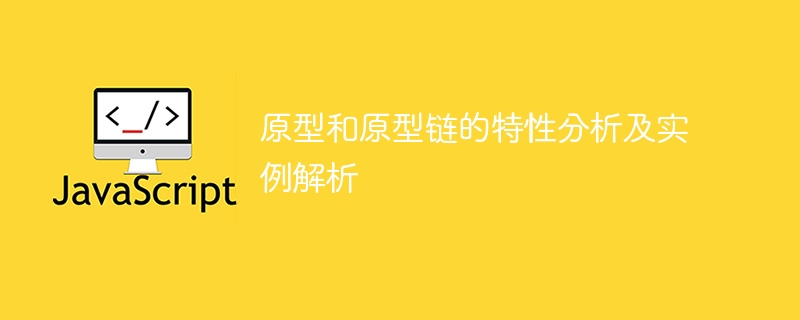Home >Web Front-end >JS Tutorial >Analyze and analyze the characteristics and examples of prototypes and prototype chains
Analyze and analyze the characteristics and examples of prototypes and prototype chains
- WBOYWBOYWBOYWBOYWBOYWBOYWBOYWBOYWBOYWBOYWBOYWBOYWBOriginal
- 2024-01-13 14:11:06628browse

Characteristic analysis and example analysis of prototypes and prototype chains
In JavaScript, prototypes and prototype chains are key concepts for understanding objects and inheritance. For beginners, this can be a rather abstract and difficult concept to understand. This article will introduce the characteristics of prototypes and prototype chains in detail, and help readers better understand through example analysis.
- Characteristics of prototypes
Every JavaScript object has a prototype. The prototype can be an object or null. When we create an object, JavaScript automatically adds an implicit prototype. We can access the prototype through the __proto__ attribute.
Example analysis:
var obj = {}; // 创建一个空对象
console.log(obj.__proto__); // 输出Object.prototypeIn the above example, we created an empty object obj. When we access its prototype through __proto__, the output is Object.prototype.
- Characteristics of the prototype chain
Every object has a prototype, and the prototype itself is also an object, and it may have its own prototype. This forms a prototype chain. The role of the prototype chain is to implement object inheritance. When we look up a property on an object, if the property does not exist on the object, JavaScript will search up the prototype chain until it finds the property or reaches the top of the prototype chain (i.e. null).
Example analysis:
function Person(name) {
this.name = name;
}
Person.prototype.sayHello = function() {
console.log('Hello, ' + this.name);
}
var person = new Person('Alice');
person.sayHello(); // 输出Hello, AliceIn the above example, we defined a Person constructor and added a sayHello method to its prototype object. Then we created a person object through the new keyword and called the sayHello method. When we call person.sayHello(), JavaScript will look for the sayHello attribute on the person object. If it cannot find it, it will continue to search on the prototype of the person object. Finally, it will find the sayHello method and call it successfully.
- Application of prototype and prototype chain
The characteristics of prototype and prototype chain allow us to easily implement object inheritance, thereby reducing the amount of code duplication. By adding methods and properties to the prototype, you can achieve the purpose of sharing these methods and properties with all instance objects.
Example analysis:
function Animal() {}
Animal.prototype.eat = function() {
console.log('Animal is eating');
}
function Dog() {}
Dog.prototype = Object.create(Animal.prototype);
Dog.prototype.bark = function() {
console.log('Dog is barking');
}
var dog = new Dog();
dog.eat(); // 输出Animal is eating
dog.bark(); // 输出Dog is barkingIn the above example, we defined an Animal constructor and added an eat method to its prototype object. Then we define a Dog constructor and point its prototype to the Animal instance object. In this way, the instance object of Dog can access both the method eat on the Animal prototype and the method bark on the Dog prototype.
Summary:
Prototype and prototype chain are important and basic concepts in JavaScript. By understanding prototypes and prototype chains, we can better understand the principles of objects and inheritance. At the same time, the application of prototypes and prototype chains can also greatly reduce the amount of code duplication. When writing JavaScript code, it is very necessary to have a deep understanding and flexible use of prototypes and prototype chains.
The above is the detailed content of Analyze and analyze the characteristics and examples of prototypes and prototype chains. For more information, please follow other related articles on the PHP Chinese website!

